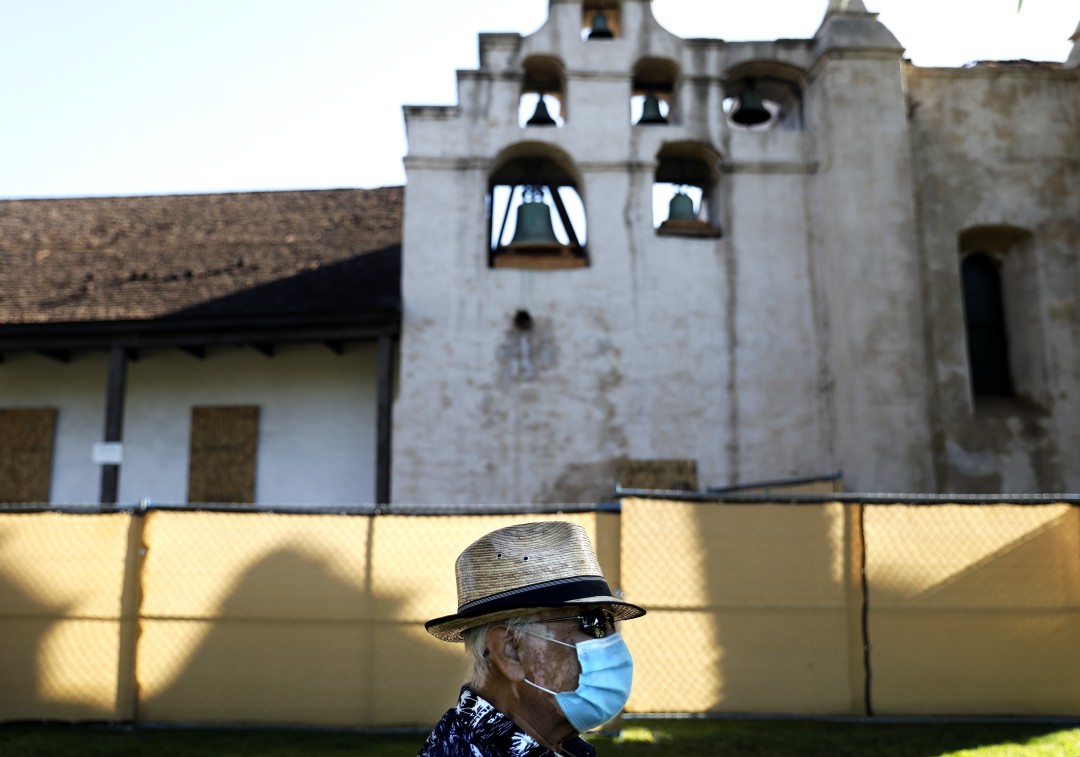Mission San Gabriel burned over the weekend, suffering devastating damage. No conclusions have been drawn about the cause of the fire, but some suspect arson. Though nobody I have read has said anything, I wonder if anyone has made a connection between possible arson and recent attempts to remove monuments to the Franciscan missionary Junipero Serra. He founded the Mission San Gabriel in 1771.
On Monday morning the Los Angeles Times ran a well-reported story about the mission and its meaning in the aftermath of the fire. “Pain resonated around the valley that bears San Gabriel’s name in the wake of the fire,” Gustavo Arellano wrote. “It manifested in ways that told multiple stories about the mission.” Some, Arellano wrote, saw the mission “as a place of horror: where Native Americans toiled under brutally domineering Spaniards and were nearly exterminated.” But others found in the mission “a place that embraced them when few others would,” welcoming immigrants and refugees to a nation that has a poor record for welcoming newcomers. It is a fantastic article, far superior to the coverage in other papers that I have read.
A historical location is different, it seems to me, from a monument, because its purpose is not solely to commemorate. People may visit and look at a monument, but they experience life in places. There was a high school at San Gabriel Mission. My wife graduated there. There was a church where generations of Californians held baptisms, first communions, weddings and funerals. The last time I was inside the mission was 2010, when we held my mother-in-law’s funeral there. In the years since, I’ve driven or jogged past the mission a handful of times.
Places matter in our lives, but why a place matters to me might be different from why it matters to you. The people who were with you when you were there, the things you experienced and that added to who and what you are–they add layers of meaning to a place and give to it significance. “This was where….”: I said that to my daughter so many times late last month as we walked around my hometown. I bored her, but the memories and meanings for me were powerful. We cannot make sense of these places entirely apart from these meanings and experiences.
I know many of my friends and colleagues cannot easily separate Mission San Gabriel from the cruelty of the Spanish Christian regime in California. Of course I get that. This history angers them, and they will engage in debate, on occasion, with those whose experiences have layered other meanings on a site.
So you think of the mission as the site of a genocide, which as a historian I understand perfectly well. But as the member of a family, I think of the mission and feel grief and anger, not primarily from this history, but from my wife’s mother’s murder by the negligence of the doctors and nurses who were supposed to care for her. Different experiences, different layers of meaning that we sift through in order to make sense of a place.


Powerful. Two sides of a complex argument defended in one piece. Your personal experience is palpable, relevant, pertintent.
Thank you for sharing your personal and insightful perspective on this event, this place and about the importance of place. It feels like being home, rooted in a place, being free, relaxed into home, being a loving, connected human is constantly under threat, and I pray for our evolution to end this choice, this enforced pain and suffering by design. We are capable of so much more.
Thanks, Claire. What a nice comment.